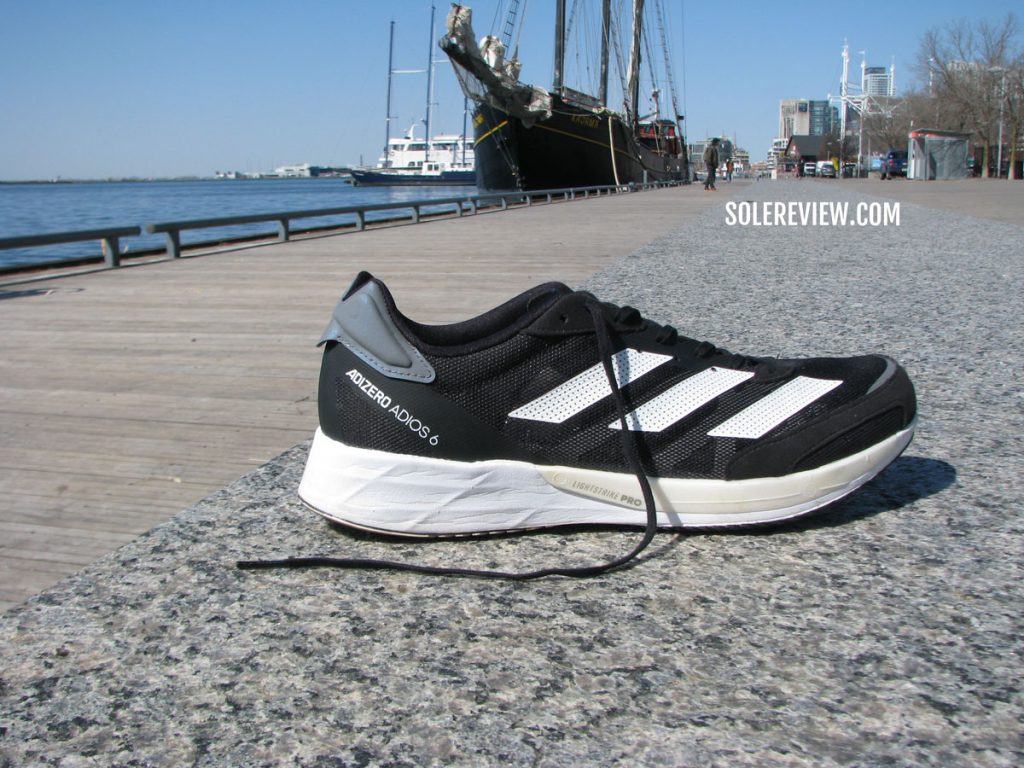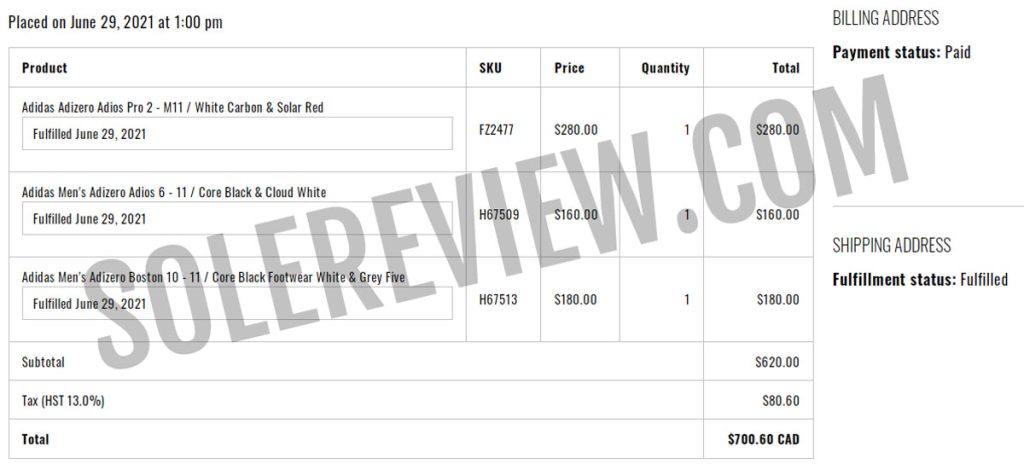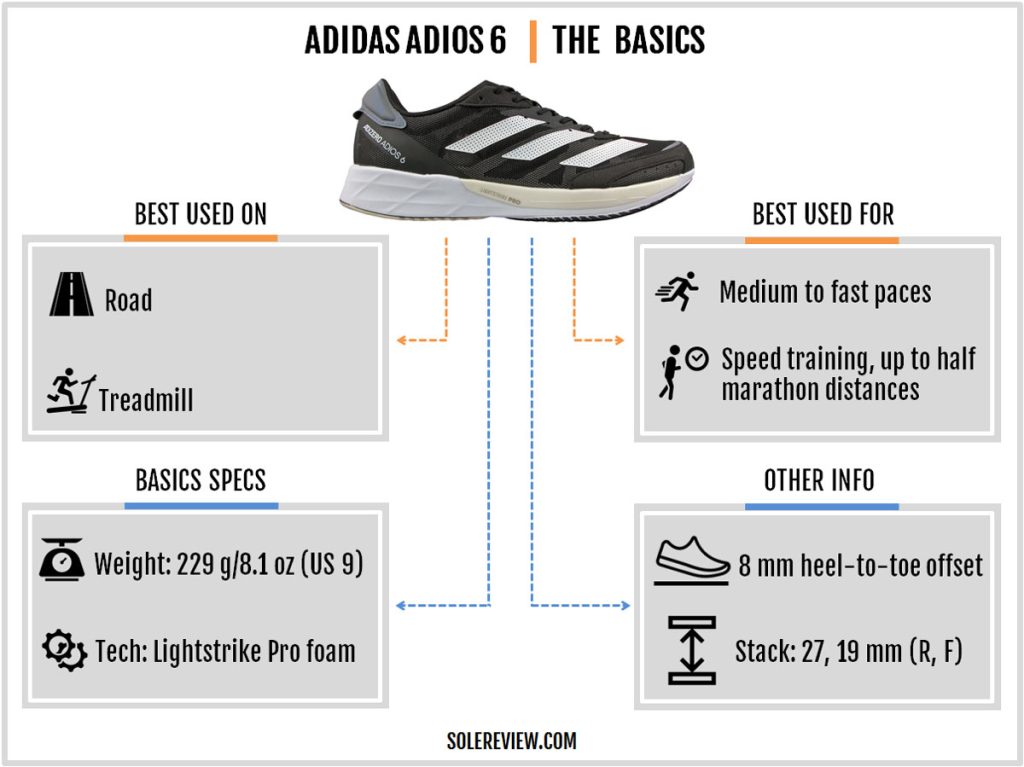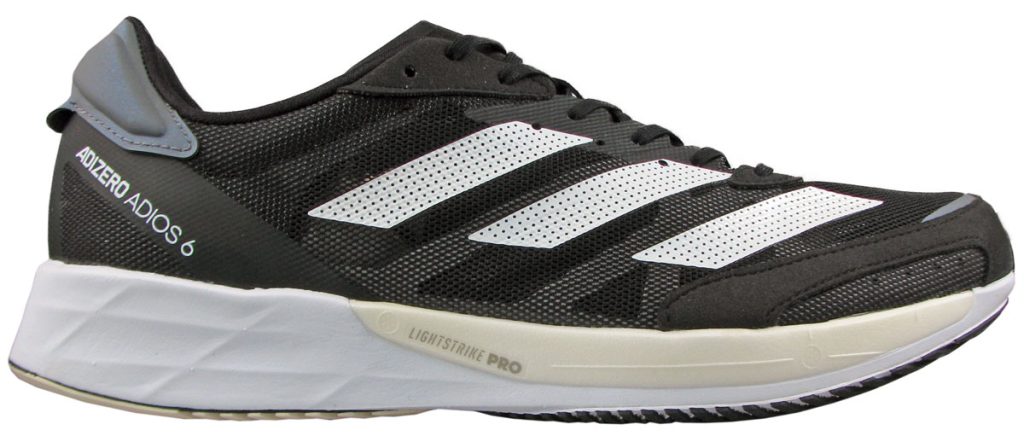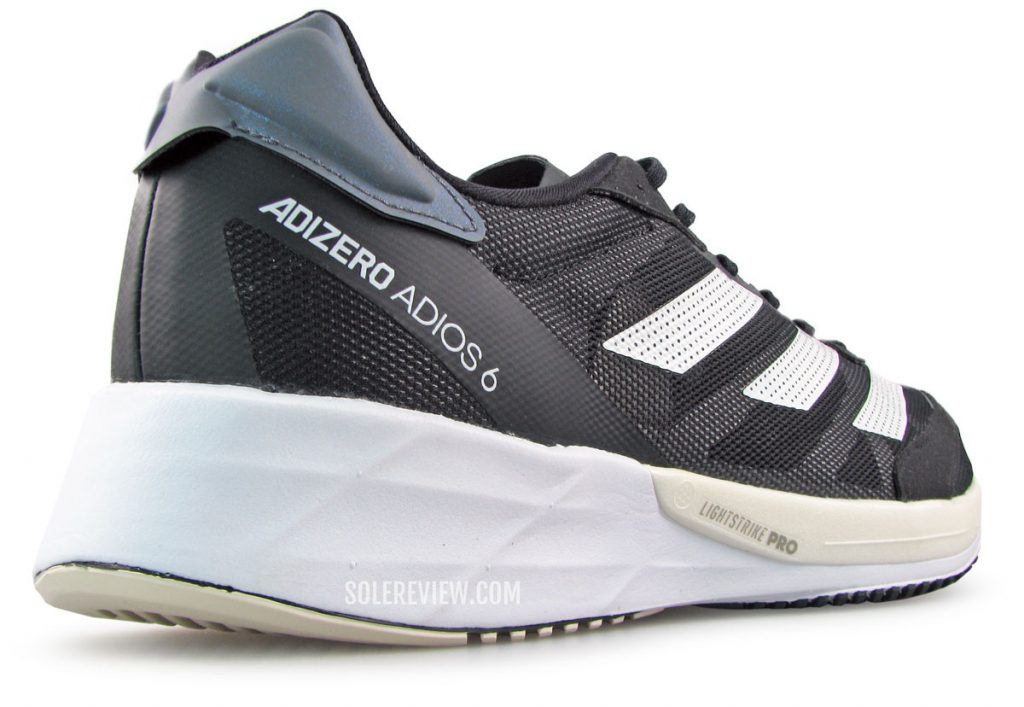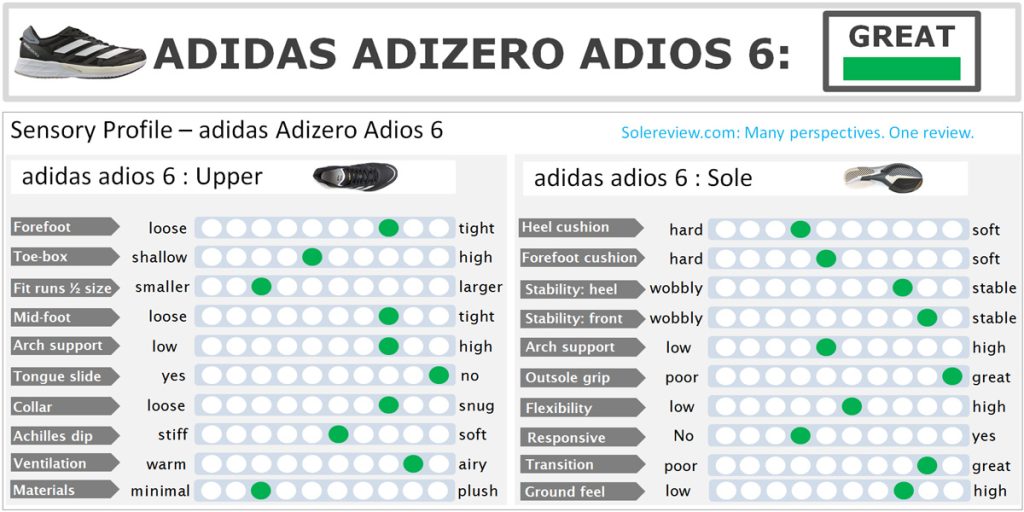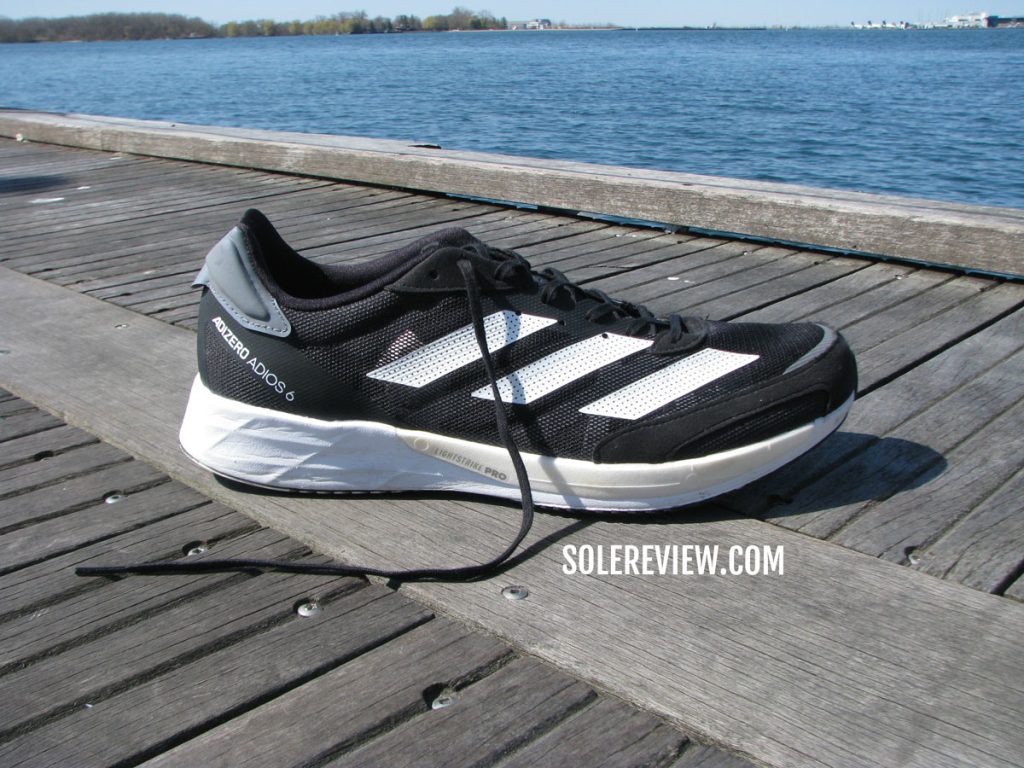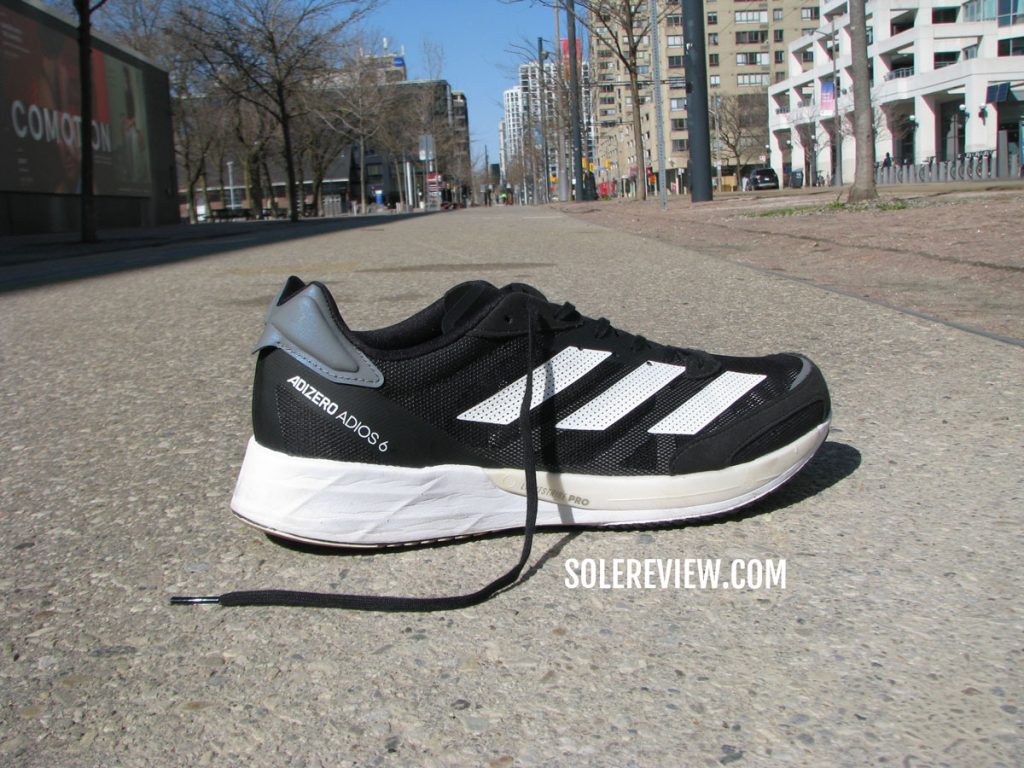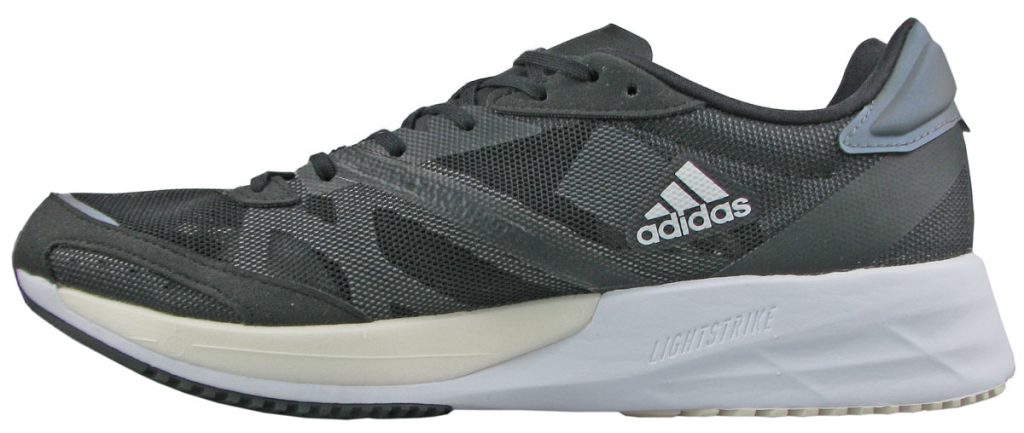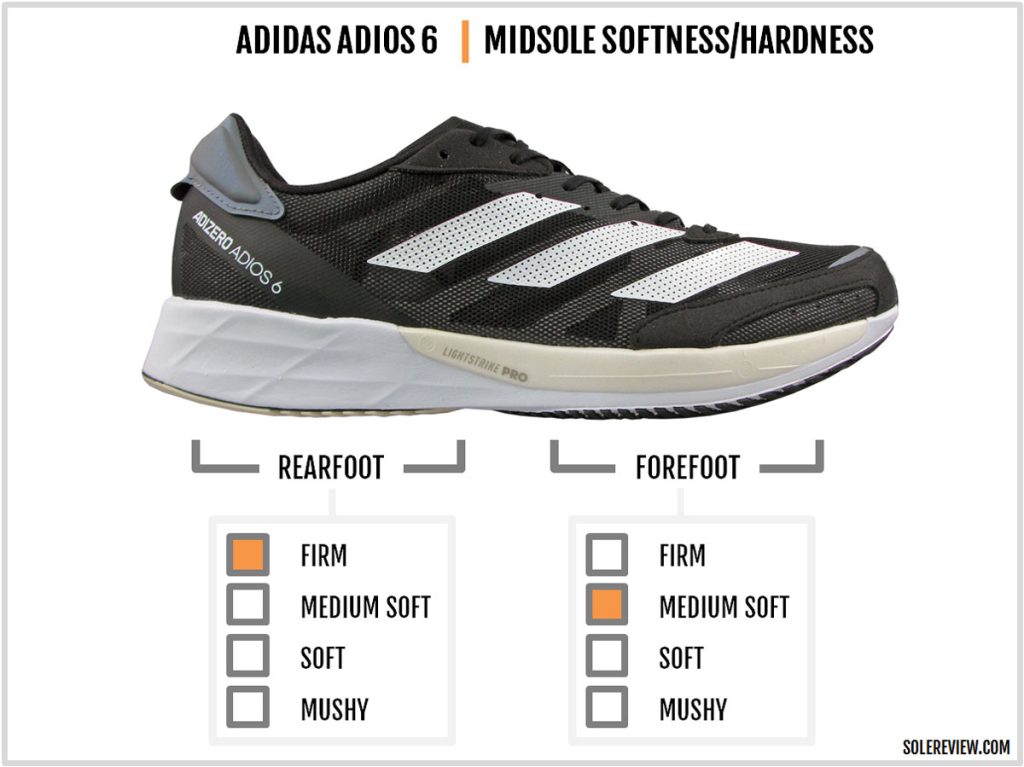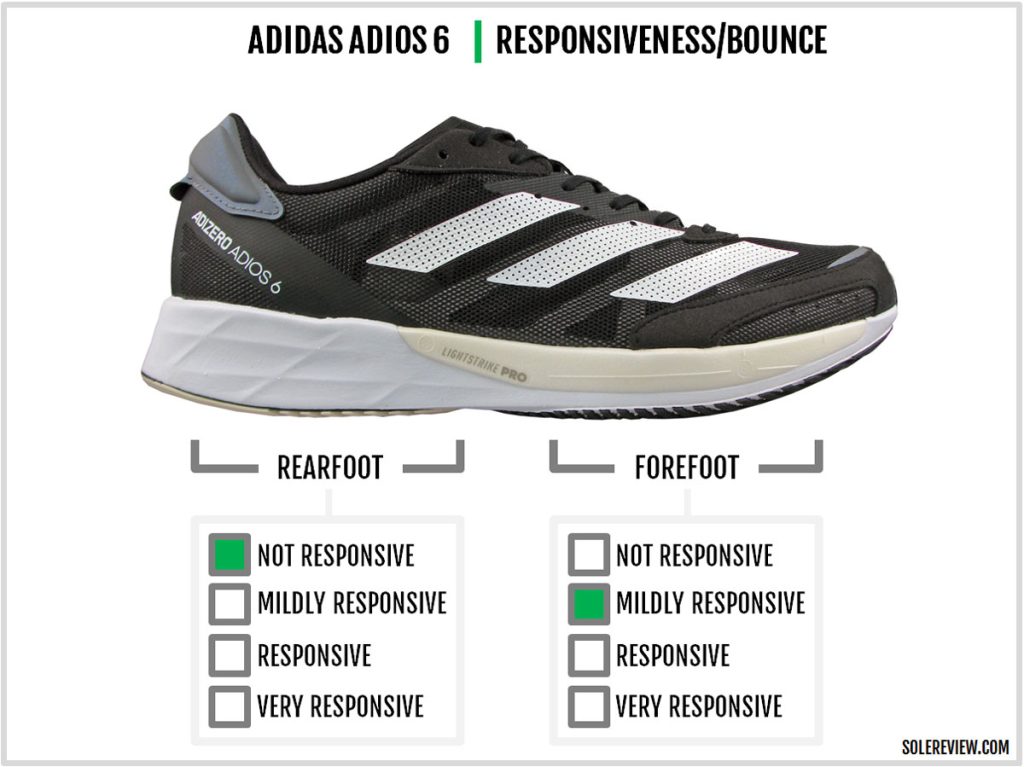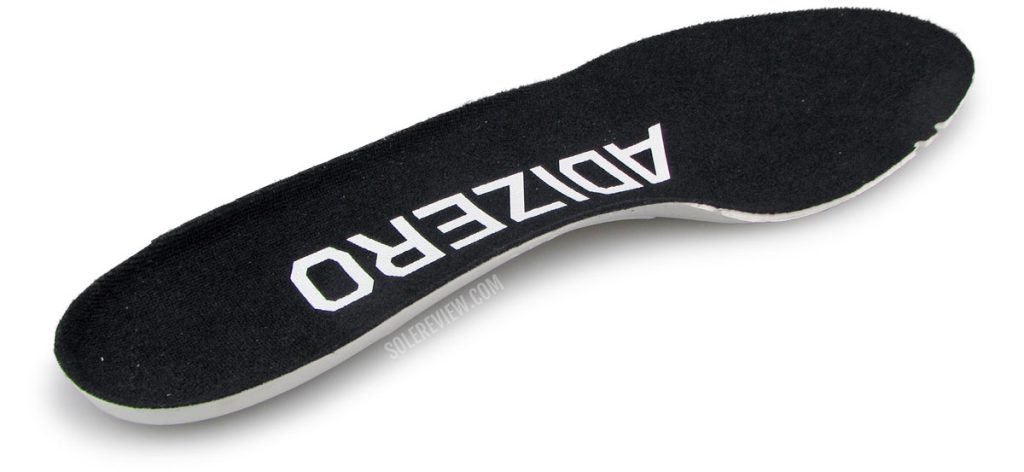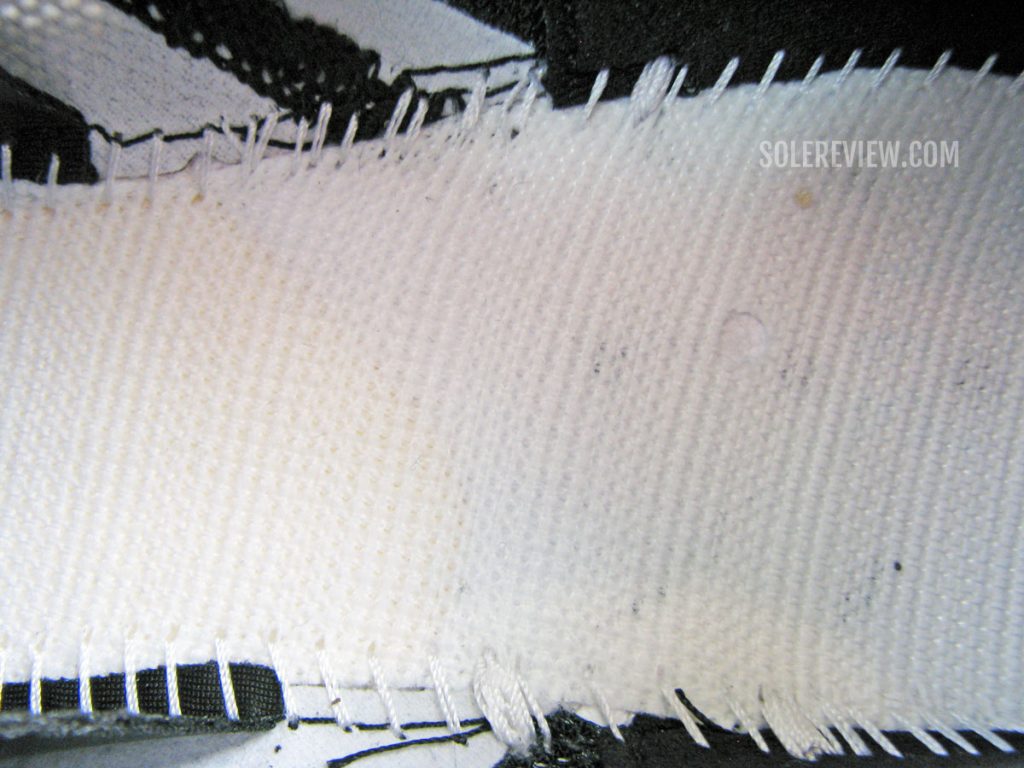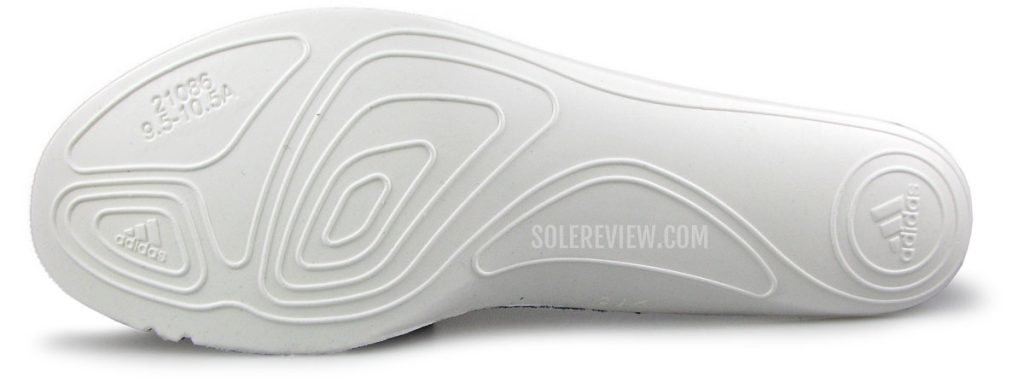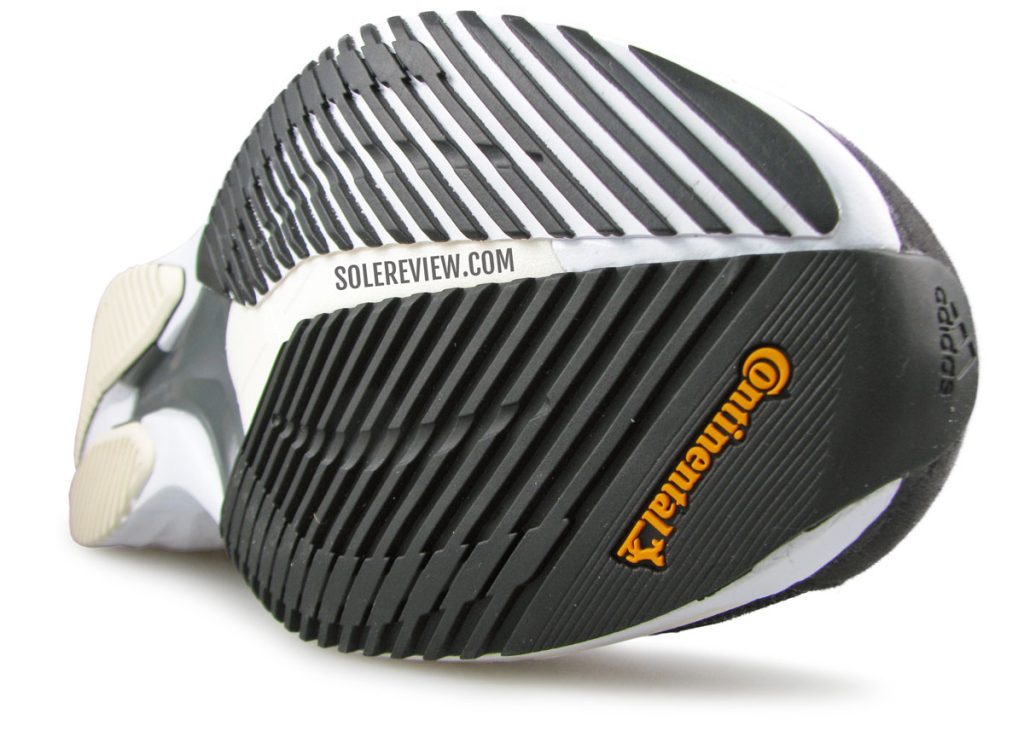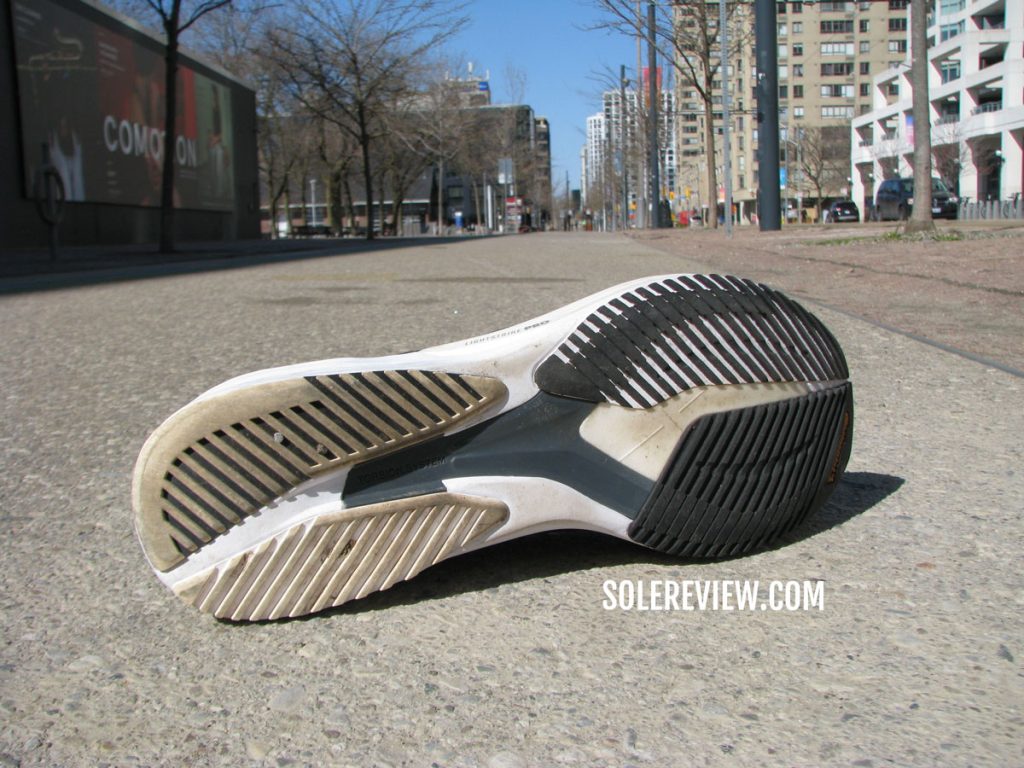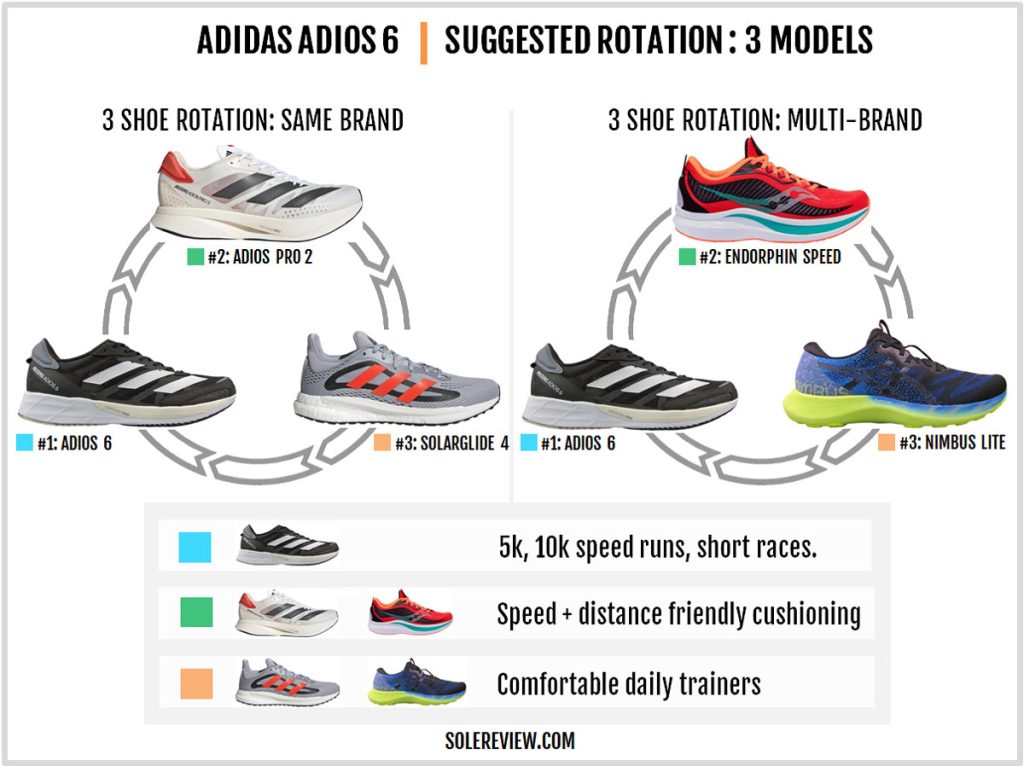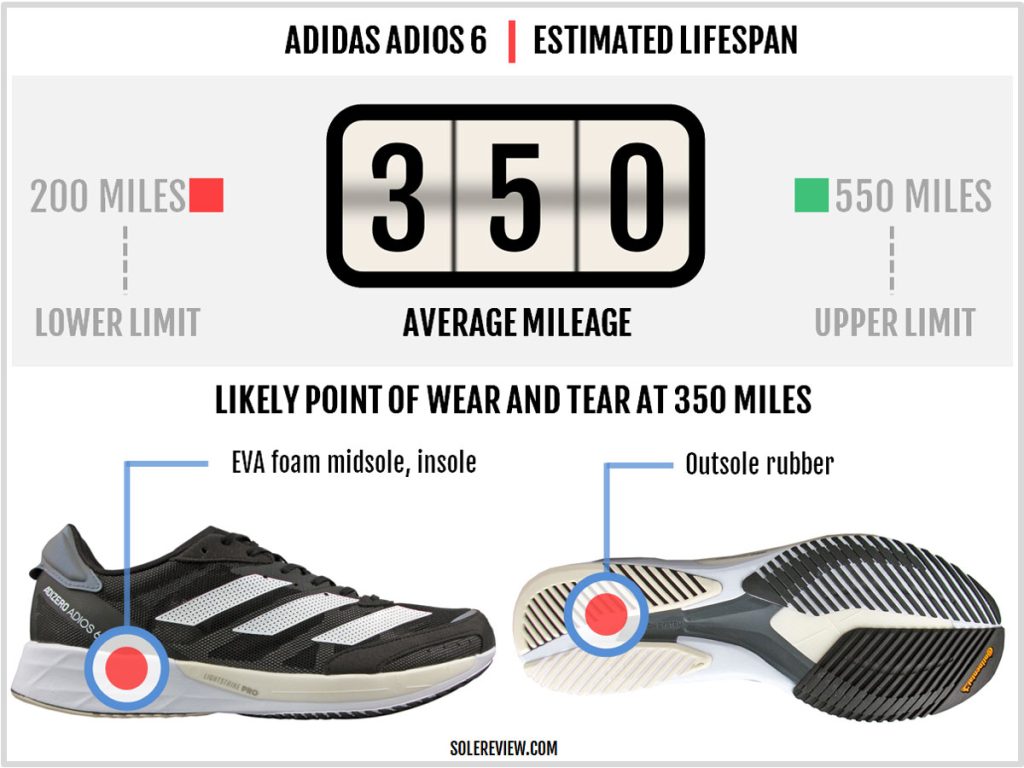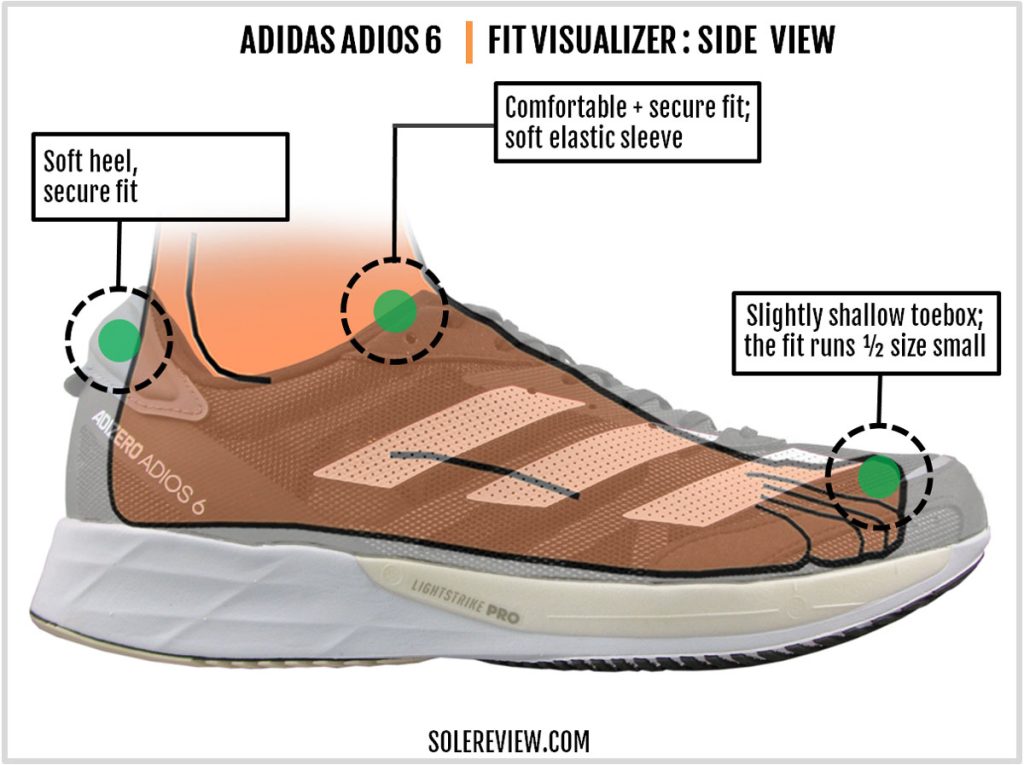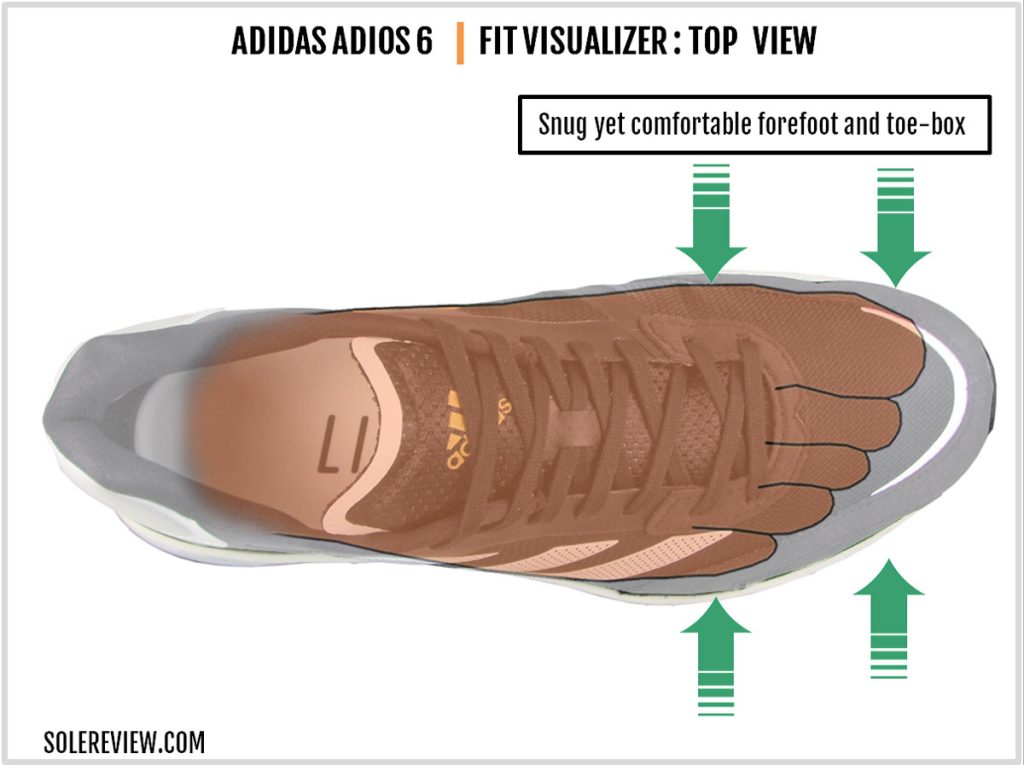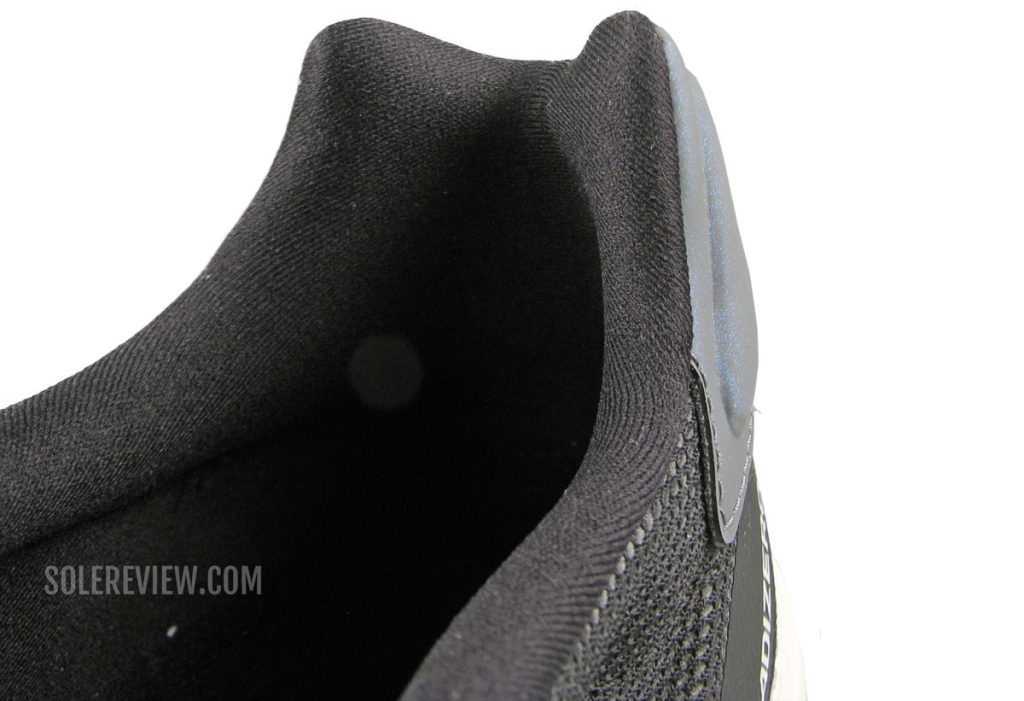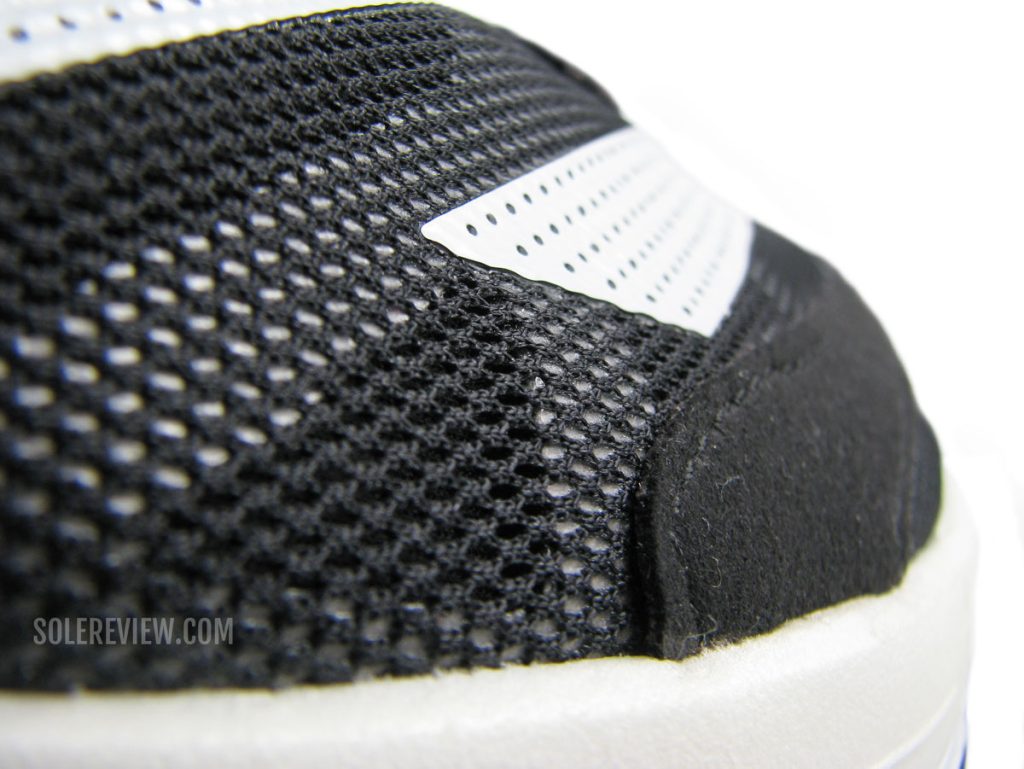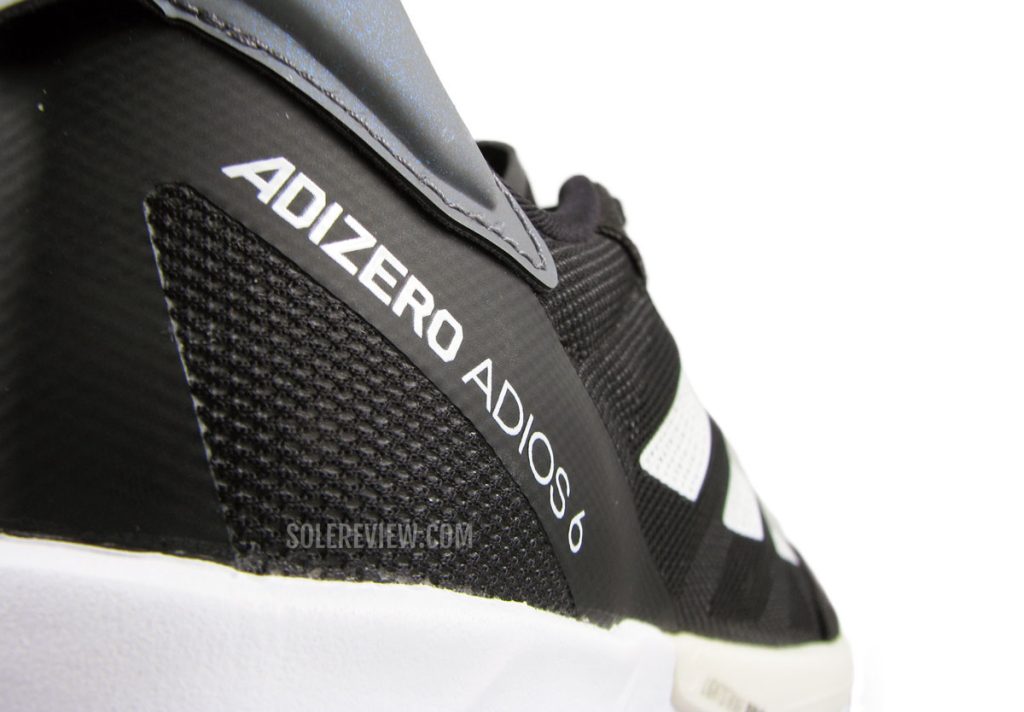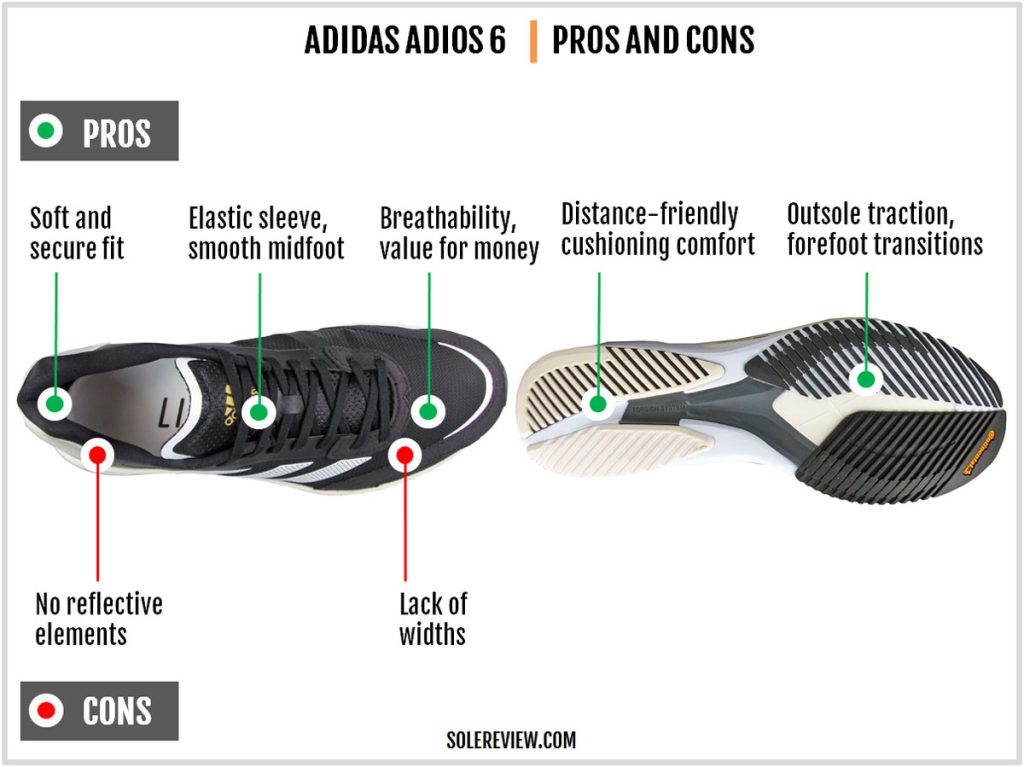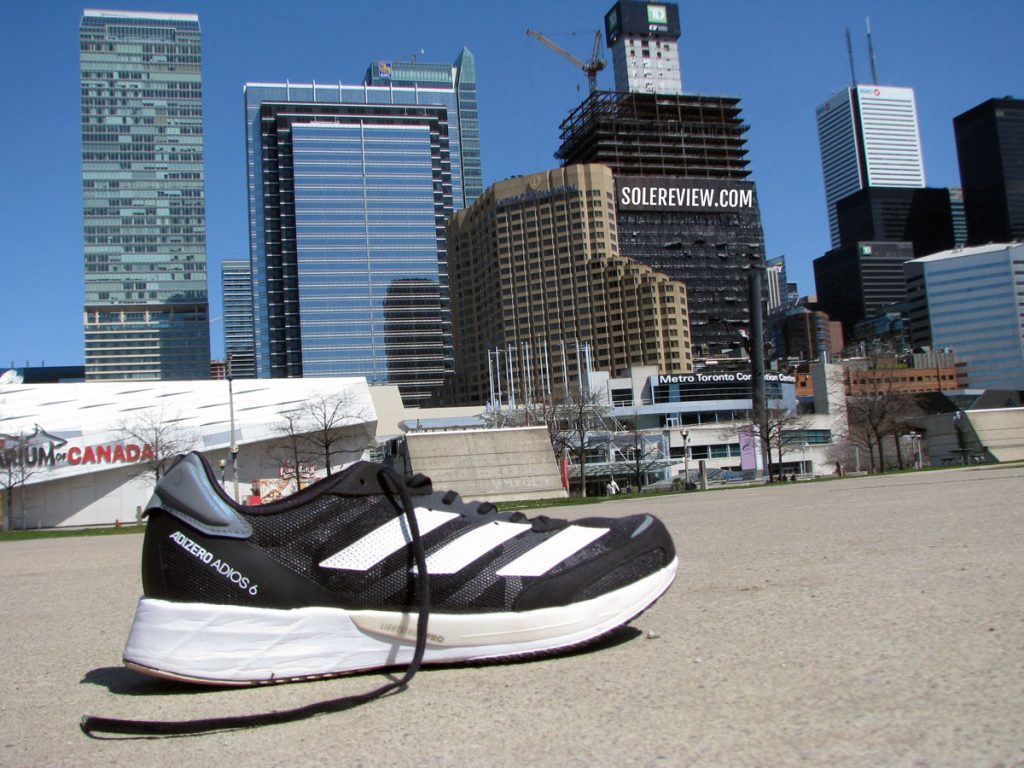The adidas adios 6 was purchased at full retail price for our review. The amount is in Canadian Dollars.
INTRODUCTION
Till a few years ago, the launch of new smartphones used to be a fun event that most people looked forward to.
Everyone who wanted to upgrade their phones were excited at the prospect of faster processors, a higher camera resolution, increased storage, or longer battery life. But after a point, the law of diminishing returns kicks in.
Sure, the new phone doesn’t need charging for 15 hours and has half a dozen cameras with a gazillion megapixels each. At the same time, it’s a 6.5-inch screen we’re talking about. Gains made in one area come at the cost of another.
There’s a parallel in the performance running footwear industry. Most speed shoes and racers now have an ultra-cushy midsole with an almost illegal stack of 39 mm and some form of a composite plate within.
We wish that was a joke; it isn’t. The World Athletics association bans any shoe with a sole thicker than 40 mm.
While the plate-in-midsole form factor is a huge leap in running shoe design, one wonders if that’s being overdone. The racing shoe and speed trainer category is a good example.
It’s very difficult to find traditional flats anymore.
Even the adidas Takumi Sen 8 now resembles the adios Pro 2; in other words, it’s acquired a cushy Lightstrike Pro midsole with Carbon ‘Energy rods’.
Much like the frothy real-estate and equities market, shoe brands have a FOMO with maximally-cushioned racing shoes.
Take our cellphone analogy. Sometimes, all that one needs is a nicely-finished feature phone in a compact form. No internet or apps, but just the ability to talk and text. Pure function, no distraction.
That’s why we’re pleased to see the current iteration of the adizero adios 6.
While it has a much thicker midsole stack than the adios 5, it has all the essential ingredients of a legitimate speed trainer.
Its cushioned firmness joins forces with the Torsion shank to build speed; the narrow racer-like upper has a secure and distraction-free fit. The novel Continental outsole also grips phenomenally well.
With the higher level of cushioning, the new adizero adios is akin to the older Bostons or adizero Tempo.
The adios 6 delivers race-day performance but possesses sufficient comfort for runs of up to a half marathon. Runners with a higher cushioning tolerance can also use the Adios as a marathon racer.
The bulkier adios 6 weighs the same as the slimmer adios 5, which first came as a surprise. But then, the midsole no longer relies on the heavy Boost foam, thus resulting in weight savings.
On an interesting note, the adios 6 undercuts the adios 5’s price by $20. The price reduction turns the feature-packed adios 6 into great value for money.
THE ADIDAS ADIOS 6 vs. ADIDAS ADIOS 5
With rear and front stack heights of 27 mm and 19 mm, the adios 6 is considerably thicker than the adios 5.
The last Adios had stack heights of 21.5 mm and 12 mm, so the new model’s midsole is 6-7 mm taller than before. That translates into a higher level of cushioning under the foot, and the ride doesn’t feel as Spartan as the older Adios.
The adidas adizero adios 5 was a purpose-designed racer, whereas the adizero adios 6 is a versatile speed trainer – thanks to its ride comfort.
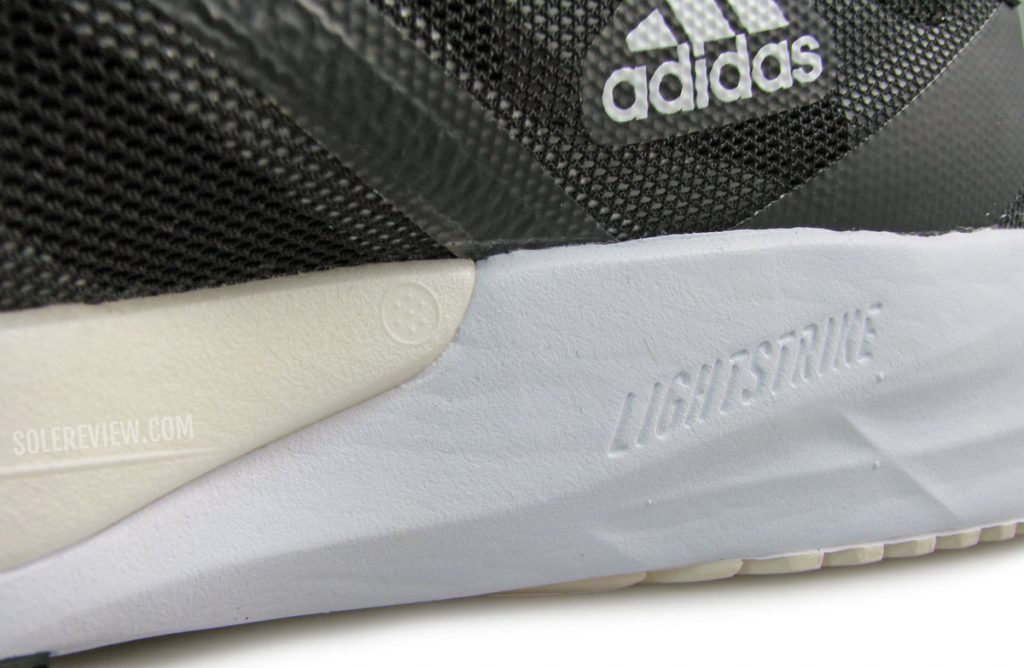
Firmer rearfoot; softer forefoot. The Lightstrike EVA foam cushions the heel, whereas the softer Lightstrike Pro adds ride comfort under the forefoot.
The increased cushioning doesn’t correspond to increased rearfoot softness. The adios 6 uses firmer Lightstrike EVA under the heel instead of the softer Boost foam that the adios 5 had.
However, the softer forefoot makes the landings and transitions less harsh for forefoot and midfoot strikers.
The adios 6’s upper is an improvement over the 5. The tongue sits flush over the foot, and the use of synthetic suede makes the upper supportive and comfortable.
THE RIDE EXPERIENCE
If we had to distill the functional difference between the adizero adios 6 and 5 into a single character trait, that would be the upside in versatility.
Its thicker stack results lead to a significant increase in ride comfort. The forefoot is now nearly 20 mm thick, so it’s nowhere as harsh as the adios V1 – V5.
As a result, easier paces do not feel like a chore. Whether you’re slowly easing into your run at 6 min/km (10 min/mile) paces or going relatively fast at 4:30 min/km (7 min/mile), the adios doesn’t struggle when shifting to a higher or lower gear, so to speak.
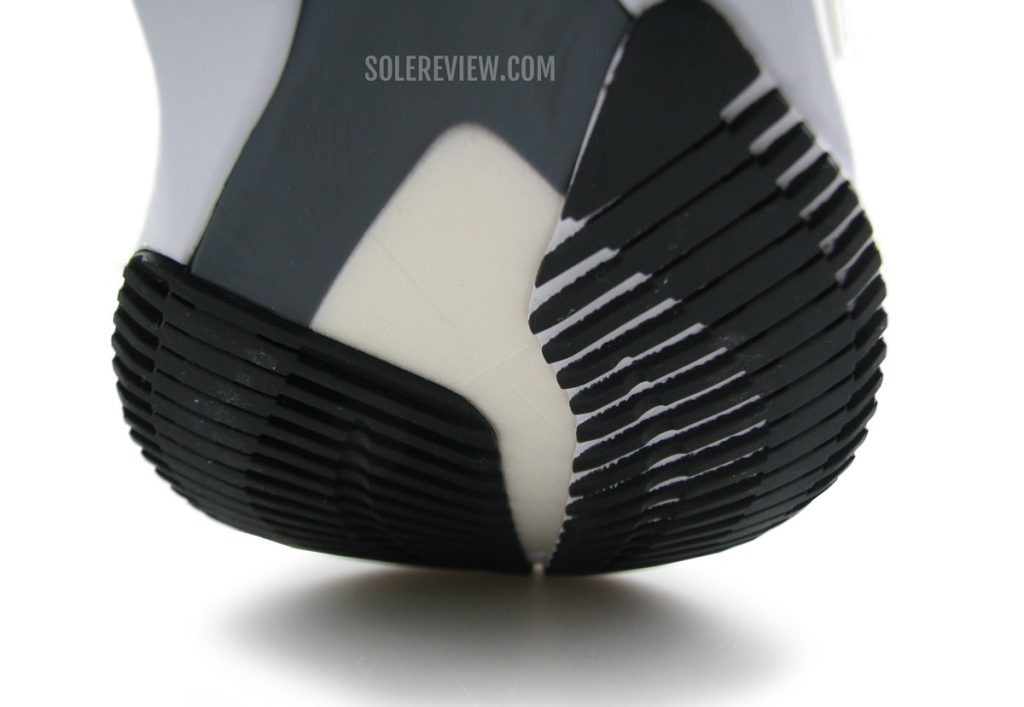
The Torsion shank ‘forks’ under the forefoot. The flat sections of the outsole mirror the shank’s path.
The adios 6 relies on a Torsion shank that not only adds midfoot rigidity, but also ‘forks’ into the front and rear. The shank also extends further towards the heel when compared to the earlier adios models.
The forks under the forefoot add a snappy layer between the soft foam and the outsole, and the longer heel-to-toe shank is effective at bridging the firm and soft midsole sections.
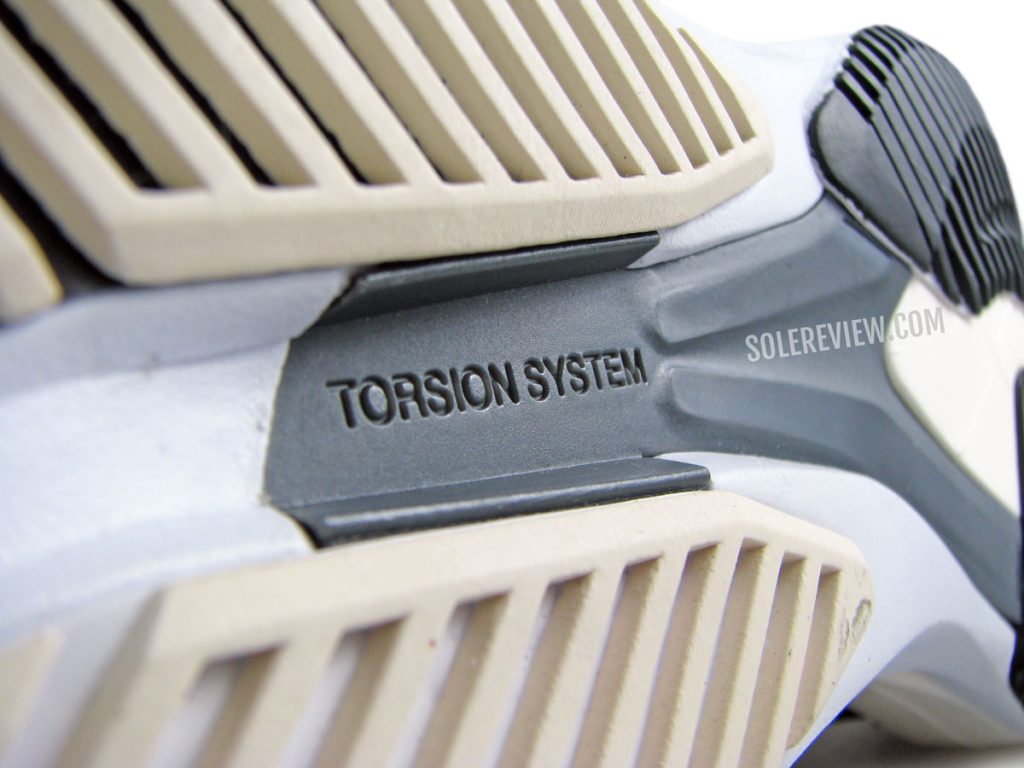
The Torsion shank is longer and extends to the heel. The recessed design adds stiffness while allowing the outsole to make contact with the surface.
However, the shank has a recessed design, so all the outsole pieces make contact with the surface for an optimal loading experience.
We’re happy to see adidas use a Torsion shank here instead of the Energy rods seen on the Boston 10 and Adios Pro 2. The flat profile of the Torsion shank is a better fit for a speed shoe like the adios 6.
Until now, all adios versions (from the V2 to V5) until now had most of the Boost foam in the rear. The adios 6 takes a different approach, and crams all its Lightstrike Pro foam under the forefoot.
Going by anecdotal accounts, most runners are migrating to a forefoot or midfoot landing pattern, so having the softer material under the forefoot supports the trend.
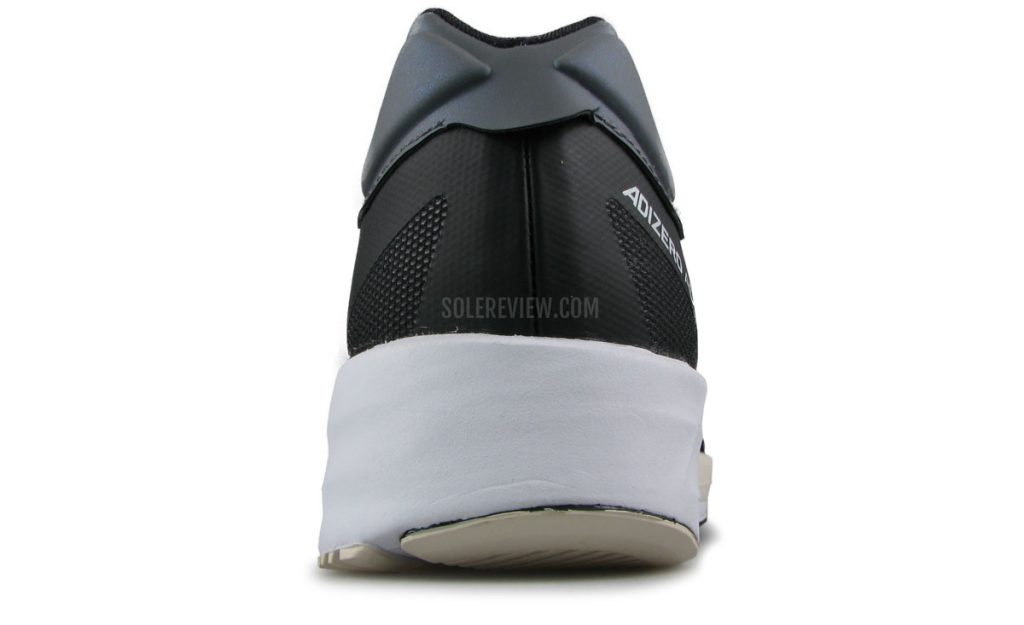
The heel is beveled for smooth transitions. The balanced design of the midsole sidewalls makes the ride neutral as well.
The 27:19 mm stack height equates to a heel-to-toe offset of 8 mm, and that’s marginally lower than the 10 mm offset that the adios used to have. From a functional standpoint, this change makes no difference at all.
The adios 6 is very forefoot strike-friendly due to its beveled heel midsole that stays close to the edge of the upper.
All that we said of the new Lightstrike Pro foam in our Boston 10 review applies to the adios 6 as well.
This isn’t a bouncy cushioning material like the Nike ZoomX or Saucony Pwrrun PB. It’s great at muffling the harshness of landings, but it lacks a springy sensation.
The mid and rearfoot uses the firmer Lightstrike EVA foam. The latter behaves like how any high-quality EVA foam does; it adds dependable ride comfort without creating a sensory theatre.
As a whole, the ride is very neutral and supportive. The newly-acquired midsole thickness does not have a detrimental effect on the stability.
Step-in comfort isn’t expected of the adios, and there isn’t any. Only a thin molded insole resides over a fabric strobel. It’s nothing special, just a compression-molded EVA foam layer with a soft textile cover.
Unlike the Boston 10, there’s no stiff board under the lasting. Our theory is that the lower midsole stack makes additional stabilizing features unnecessary.
By the way, this insole design has been in continuous use for over a decade.
The first time we saw this footbed was on the 2008 adizero CS, so it’s probably been around since the early 2000s. It’s not exactly the same, but shares a similar profile.
The Adios 6’s Continental rubber outsole is lovely. The forefoot has two large pieces with a series of slanted ribs. The outer (lateral) outsole fins are mounted over a thin rubber base, whereas the inner outsole has a solid mono-color design.
Both sides of the forefoot outsole have a flat, filled-up section to help with the transitions and increase durability.
One of the things we loved about the adizero adios 2 back in 2014 was its DSP (Dual Stencil Process) outsole that used microscopic rubber lugs over a fabric base for superlative traction.
The new Continental rubber fin design behaves like a DSP outsole; the forefoot delivers phenomenal traction over all surfaces, dry or wet.
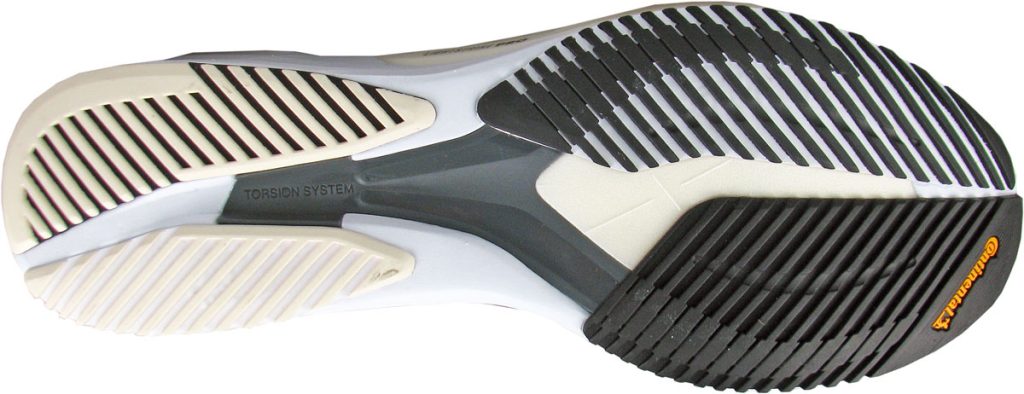
The black portion is Continental rubber. However, we’re not sure if that applies to the white outsole under the heel.
We’re not sure whether the rear section of the outsole is made of Continental rubber. Based on the wear pattern, it could be well be ‘adiwear’ rubber.
The adios fulfills the role of a racer and a speed trainer, so we don’t think a three shoe rotation (from adidas) is necessary.
Just get the durable and comfortable Solarglide 4 for easy days. And if you have too much money and don’t know where to spend it, the adizero adios Pro 2 is a good use of cash.
There’s another way to build a three shoe rotation. The Asics Nimbus Lite 2 is a comfortable everyday trainer that complements the more serious adios 6.
And rather than the adidas adios Pro 2, the Saucony Endorphin Speed 2 is a less expensive shoe that blends high-mileage comfort with a speed-friendly ride character.
IS THE ADIDAS ADIZERO ADIOS 6 DURABLE?
We have over 50 miles on the adios 6, and have yet to see signs of excessive wear.
There is some wear and tear on the white section of the outsole, leading us to believe that the rear outsole may not be made of Continental rubber.
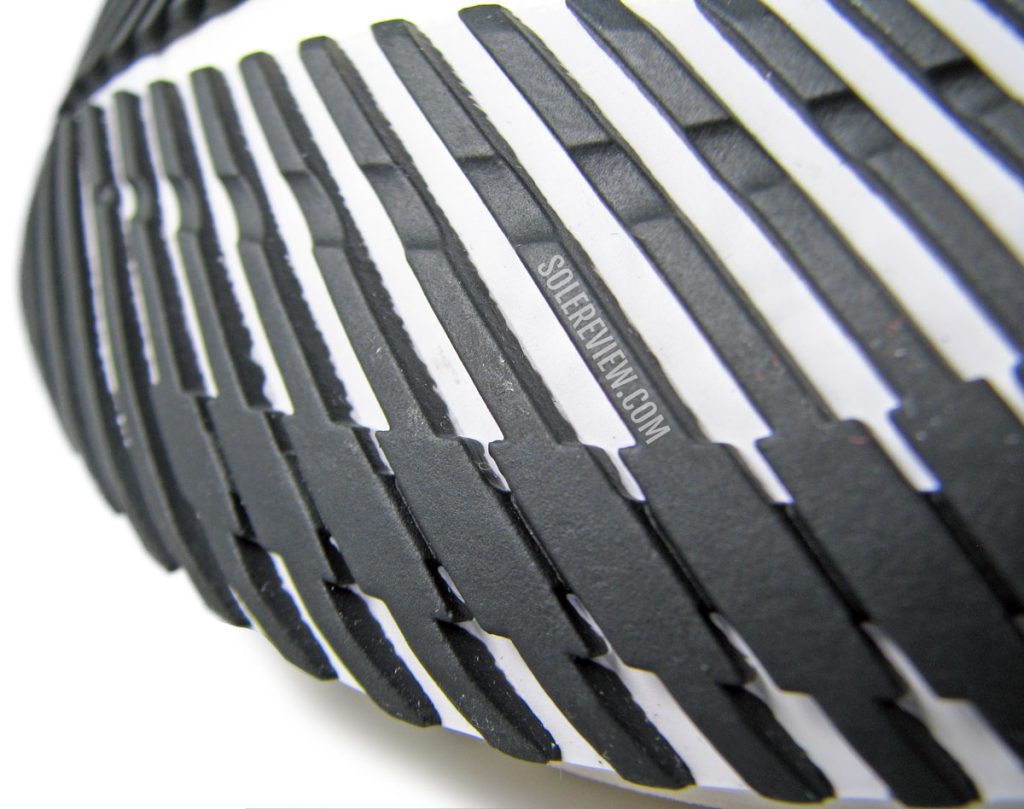
The ridges look fragile, but they’re not. The filled-up section on the side helps distribute the wear and tear.
The thin outsole ribs under the forefoot are more durable than they appear. Both the inner and outer outsole slabs have a flat ‘transition’ zone that is effective at countering the wear and tear.
The outsole is thin, but that design also allows it to move together with the midsole rather than acting against it.
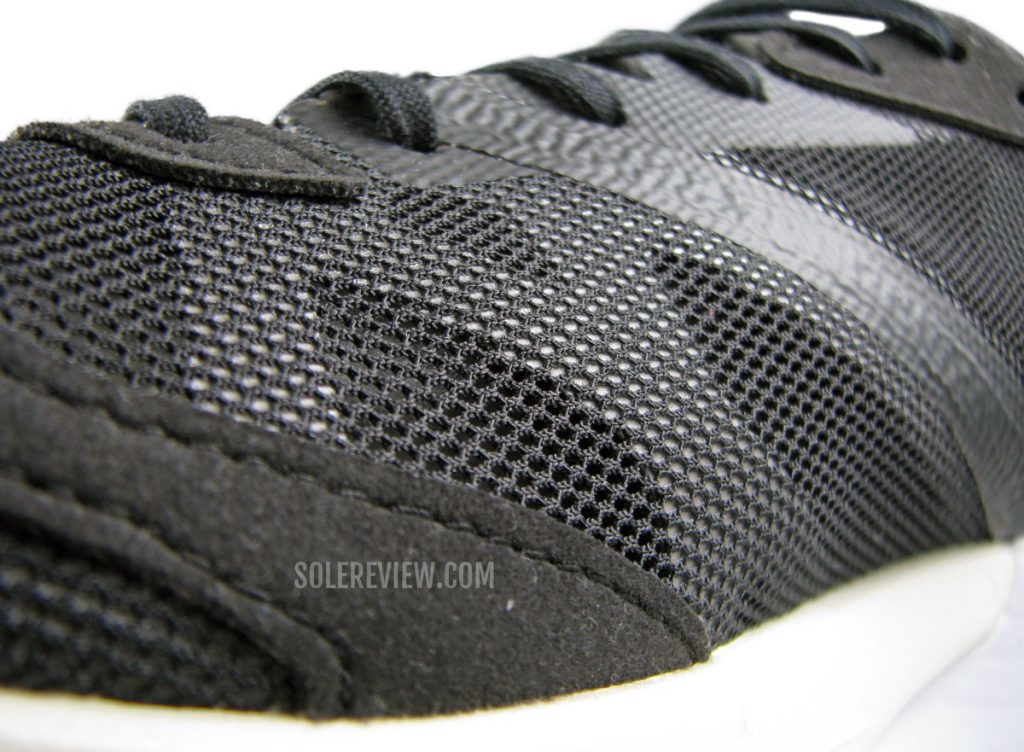
The breathable mesh is reinforced with an internal midfoot frame and ultrasonically welded seams on the outside.
Though the upper mesh looks thin, the insides are reinforced with a thicker layer. There’s also a welded seam on the outside.
The toe-box is shielded with a synthetic suede bumper, so we do not foresee premature failure.
THE UPPER DESIGN AND FIT
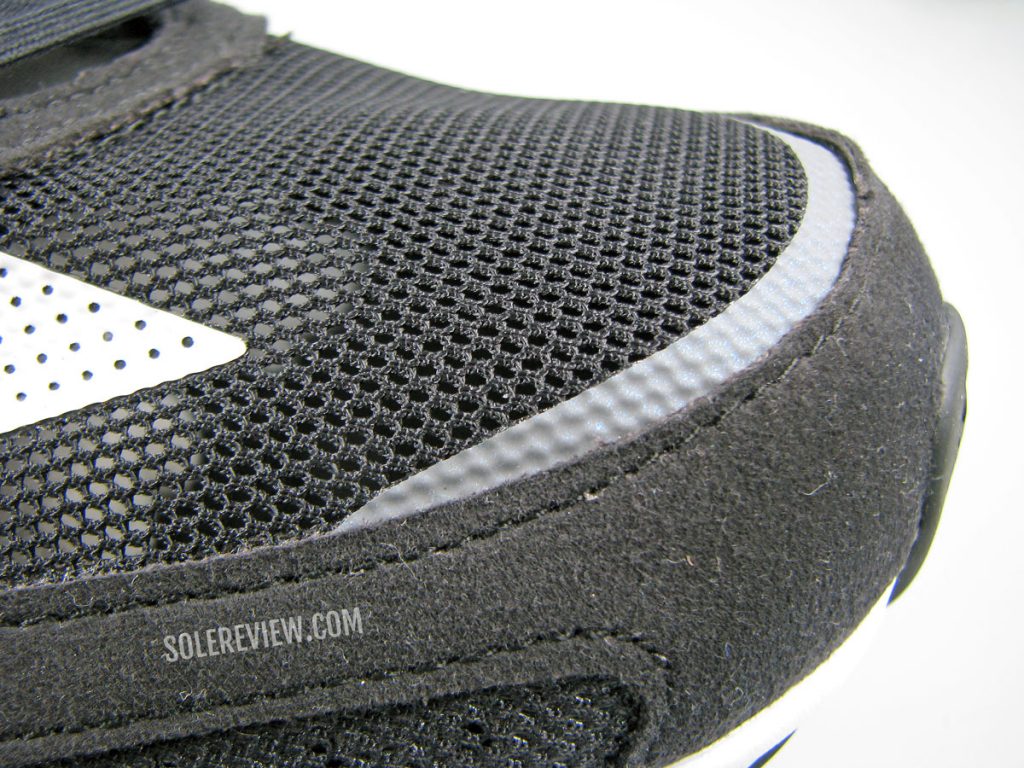
Many parts of the Adios 6 looks and feels familiar. Pictured here is the toe-box with a synthetic suede bumper.
The adios 6’s upper design takes a detour from the ultra-minimal mesh exteriors of Adios 4 and 5.
While there are recognizable elements like the lightweight (and almost see-thru) mesh and synthetic suede bits, there’s more than what meets the eye.
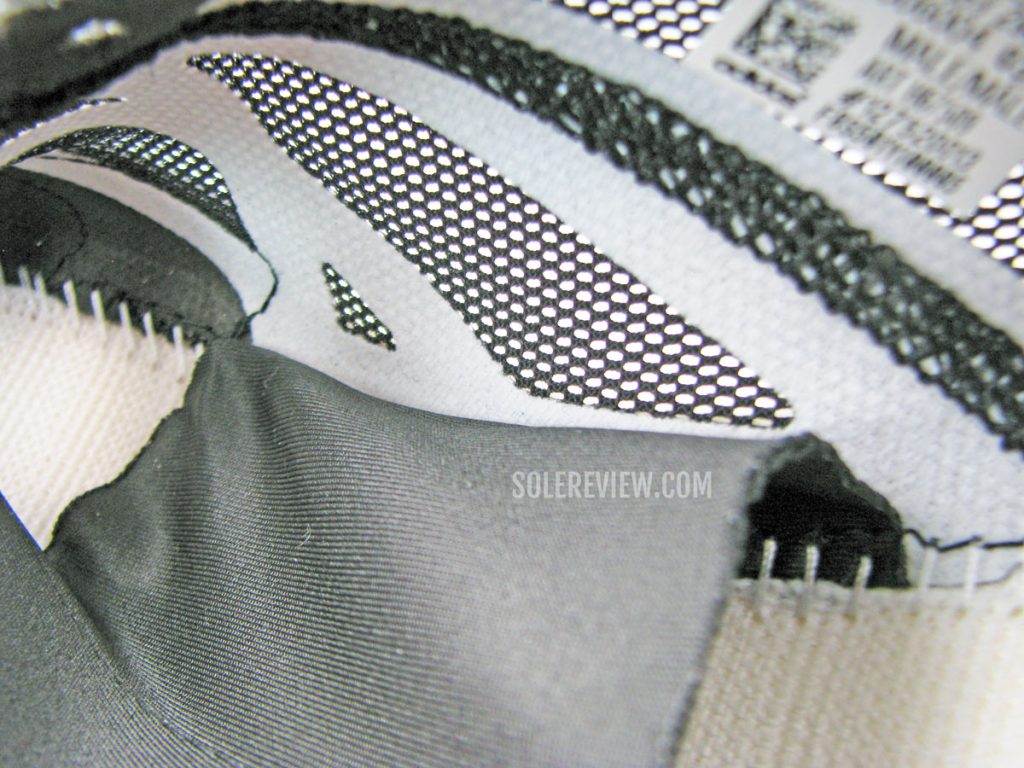
The insides are reinforced with a soft lattice-shaped frame. The gusset is soft, elastic, and is a part of the tongue.
For example, the forefoot and midfoot are reinforced with a latticed frame that adds support without affecting ventilation. The adios 6 is a very breathable shoe, and none of the interior components get in the way.
The tongue is sleeved like the adios 5, but a couple of updates helps it sit flush over the foot – something that the adios 5’s tongue struggled with.
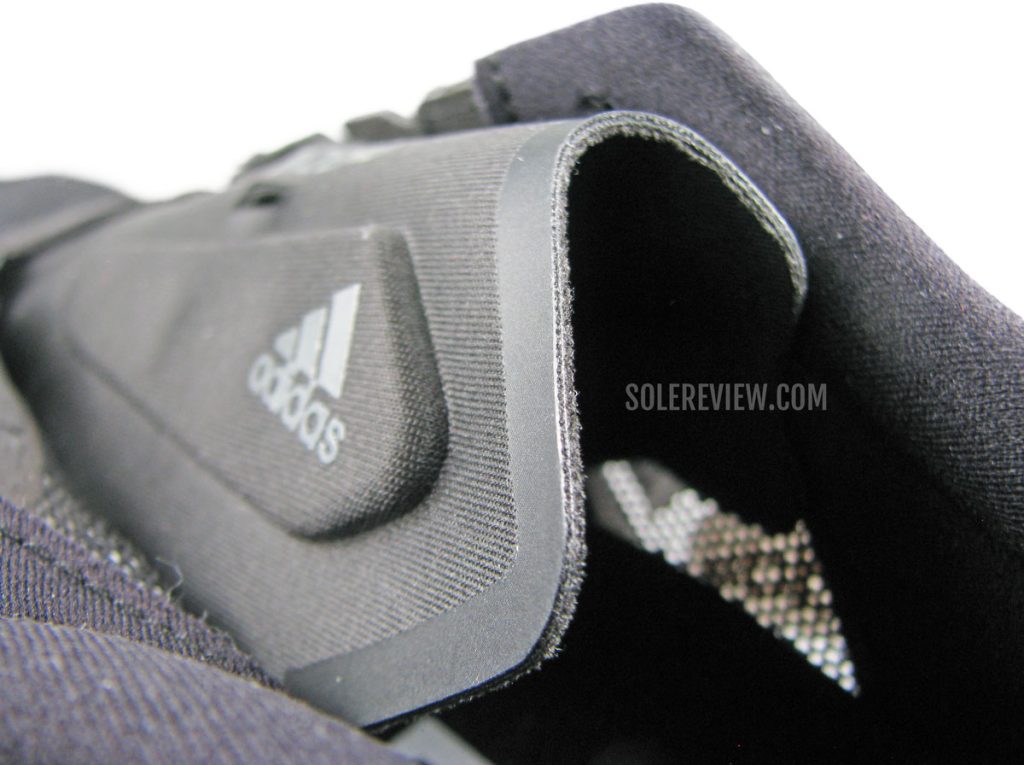
This time, the tongue flap is scooped and asymmetrically designed to help it lie flat over the foot. The molded foam pockets are effective at absorbing the lacing pressure.
The adios 6’s flap has an asymmetrical and redesigned scoop that no longer rides over the instep.
A lot of the upper comfort and fit security comes from the elastic gusset. The soft sleeve and tongue are a part of a single pattern, thus making seams redundant.
Runners who have previously owned the adios 2 and adios 3 will remember the scratchy tongue edges that also tended to fold over.
The adios 6’s fit is snug and almost true to size. The reason why the adios 6 feels short is its pointy toe-box over a slim midsole.
The upper is flush against the large toe, so the adios feels shorter than it is.
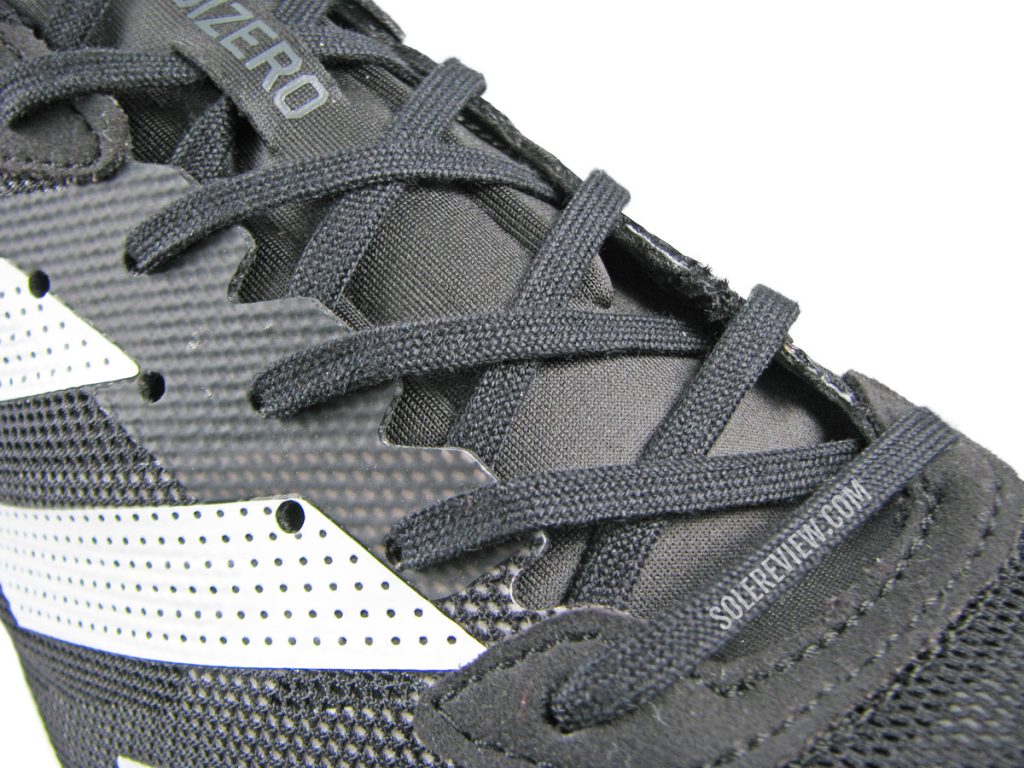
The long lacing makes the fit more secure. Notice that there are three additional eyelets for variable lacing. This is new for the adios 6.
The narrow fit will not come as a surprise to anyone who is familiar with speed-training shoes. Besides the last, the lacing design also plays a part here. The first lacing row starts over the forefoot rather than the midfoot, as is the case with regular neutral trainers.
This way, most of the upper fit is controlled by the laces. However, the tongue does an excellent job at filtering the top-down pressure. The molded foam pockets on the tongue surface help take the edge off.
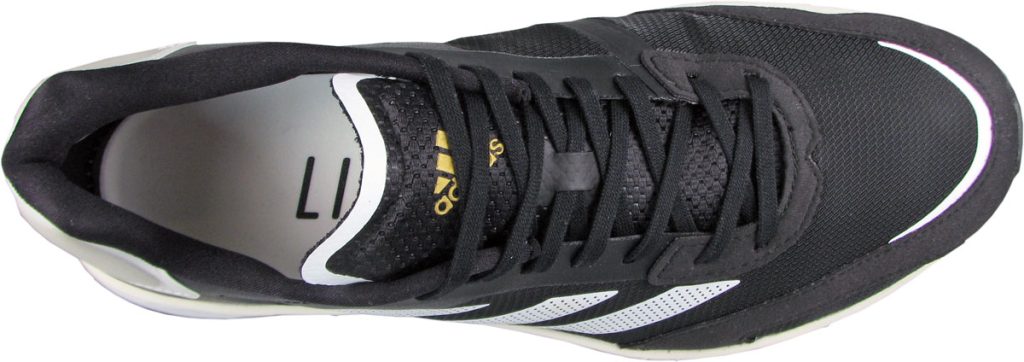
Unlike the past adios editions, the V6’s lacing is skewed asymmetrically to minimize pressure hot spots. The tongue flap also has an asymmetrically-scooped flap.
The adios 6’s asymmetrical lacing is worth noting. Unlike the adios 5, the first lacing is slanted to reduce the pressure without compromising the quality of fit.
The adios 6 also has three additional eyelets on the outer midfoot. These variable lacing eyelets can make the midfoot fit tighter if required.
In the rear, the heel fits securely without slippage or irritation. The stiff internal counter stabilizes the foot over the midsole, whereas the soft and padded collar adds interior comfort.
Those were the basics. Besides that, there are other things we like about the adios 6’s upper.
Using synthetic suede on the last three lacing rows is a thoughtful touch. This results in a soft hand feel during the lacing process.
adidas also uses a lot of ultrasonic welding that allows the adios 6 to maintain its 8-ounce weight despite being a bulkier shoe.
The inner midfoot seam is welded, and so is the lacing eye-stay and heel overlay. The three stripes logos are applied through high-density printing.
adidas claims that the adidas adios 6 uses recycled materials aka Primegreen. However, it doesn’t say what percentage of the upper is constituted of Primegreen.
We wished that adidas made the heel piece reflective. It looks reflective at first, but it’s merely glossy and doesn’t reflect light as a high-visibility trim should.
PROS AND CONS
Leaving aside the lack of widths and reflectivity, we have mostly great things to say about the adios 6. Even with the significantly taller midsole, the transitions are effective and quick.
The dual-density midsole, Torsion shank, and ultra-grippy Continental rubber outsole play well together to deliver a speed-friendly ride.
We love the breathable upper that fits securely without compromising interior comfort and durability. The $120 retail price is the best part of it – the Adios 6 is a feature-rich shoe.
And if you haven’t already realized it, this is the least expensive adizero adios so far.
SHOES SIMILAR TO THE ADIDAS ADIZERO ADIOS 6
The adios 6 has changed a lot since the last version, so comparing it with racing flats would be a waste of screen space. Instead, we have to move up the cushioning hierarchy to find comparable shoes.
That brings us to models like the Brooks Hyperion Tempo, a lightweight speed trainer with a firmly cushioned midsole.
The Skechers GoRun Razor+ and Razor Excess are based on a similar midsole architecture as the Brooks Hyperion, so they deliver a similar speed-friendly ride.
Among the others, significantly cheaper Asics Hyper Speed also delivers a lot of value. It’s got a thicker midsole under a comfortable upper, so it’s not as punishing as the older Hyper Speed models.
Lastly, if you’re looking for no-frills racing flats, here’s the relevant buyer’s guide for you to read.
Do you own this shoe? Improve this review by sharing your insights – submit a review here.

